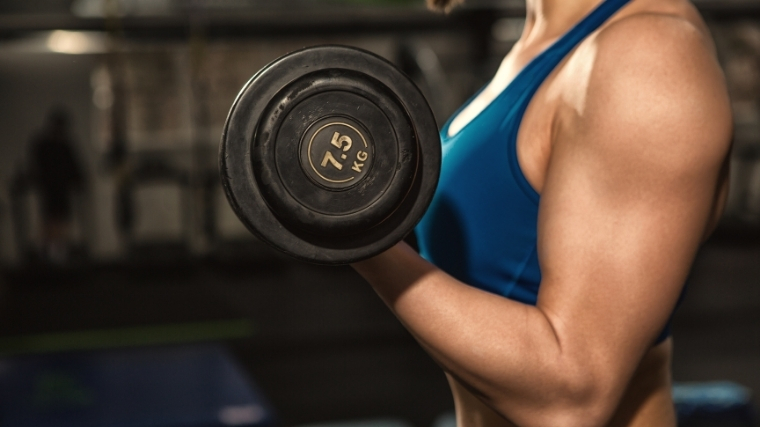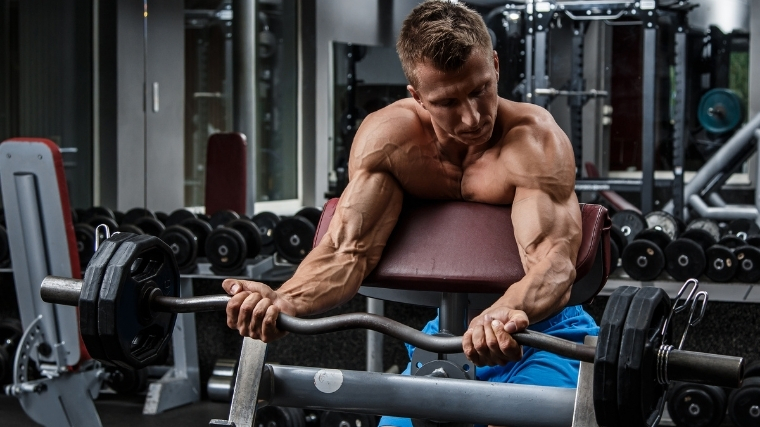When someone asks you to make a muscle, do you hit a most muscular and flex your traps? Do you roll up your shorts and tense your quads? We wouldn’t judge you if you did, but, no — you flex your biceps. Big biceps let the world know that you lift. They’re aesthetically pleasing, and it’s OK to want to look good. Beyond pure brawn, stronger biceps also aid in pulling movements like bent-over barbell rows and even deadlifts.
Of course, why you want to train your biceps depends on your goal. If you’re a powerlifter or strongman, training your biceps can help you with your pulling exercises and potentially help prevent a biceps tear. Bodybuilders need big arms to complete a stage-worthy physique. CrossFitters require conditioned biceps to endure hundreds of reps. And strong biceps can help Olympic weightlifters pull during the clean & jerk and also stabilize overhead loads.

[Related: The Best BMR Calculator for Fat Loss and Muscle Gain]
About the Biceps
Your biceps, aka biceps brachii, is the round muscle that lies on the front of your upper arm between your shoulders and elbow. Your biceps are split into two heads — short head and long head — which stem from your scapula (shoulder blade) and meetup in the middle of your arm. It’s the muscle responsible for flexing your elbow joint. Though they can be trained partially through compound pulling movements, the biceps can only be directly trained with curling exercises.
Aside from the gun show you can give everyone with your biceps, they’re important for many of the lifts you do. How strong your biceps are will carry over to bigger compound movements, such as pull-ups, deadlifts, and barbell-bent over rows since they’re used as a secondary muscle in pull movements. For these reasons, it’s important to develop your biceps brachii to their full capacity.
Your biceps primary function is for the flexion of your elbow and supination of your forearm. It’s the prime mover of your forearm, and it helps with shoulder elevation as well since it intersects with your glenohumeral joint.
5 Biceps Workouts to Try
If your arm day needs a touch-up, give any of these five workouts — divvied up by sport and goal — to pump up your sleeve-stretchers.
For More Muscle
If your a typical gym-goer and you’re looking to add a layer of muscle to your arms, training your biceps for more muscle will require a certain amount of volume (determined by sets and reps scheme) compared to other programs.
You must make sure you’re in the right rep range to stimulate muscle growth to maximize your biceps size. A good rule of thumb is to keep the rep range in the eight to 12 rep range. This specific rep range allows you to lift heavy-enough weight for enough time to stimulate the right amount of mechanical tension, which sparks hypertrophy. Select a weight to lift for two more reps than the end range of your rep count (so 14 reps in this case).
You’ll also want to do about two to four sets per exercise, depending on the movement. For movements that allow you to use heavy weight — like the barbell curl — keep the reps lower and sets higher since the heavy weight won’t allow you to do as many reps. For movements that are best for repping out lighter weights — cable curls, for example — keep the reps higher and sets lower since the lighter weight will allow you to do more reps, increasing your volume.
You’ll want to aim for 10 – 14 total sets per workout. Start with one arm workout per week, and then add another once your gains begin to plateau. Also, you’ll want to rest between 90 seconds and two minutes between each set — long enough so that you can still push yourself on weight, but not too long that you’ll go cold.
The Workout
- Barbell Curl: 4 x 8
- Dumbbell Hammer Curl: 3 x 10
- Cable Curl: 2 x 12
- Dumbbell Concentration Curl: 2 x 12
For Strength
It’s not uncommon for lifters to compare their bodies to a car — eat the right fuel, focus on the details, make sure you get plenty of mileage out of it. It’s a common but apt trope. If muscle mass is the spoiler, bumper kit, and rims — then strength is the engine. And just because your biceps are a small muscle doesn’t mean they can’t be mighty. Stronger biceps are more resilient, so even if you could care less about sporting mountainous muscle peaks, you’ll need them to help you deadlift, bench press, and press weight overhead. The biceps are, after all, what flexes your elbow joint.
When you’re training for strength, you’ll keep the volume lower — fewer reps and sets — but you’ll lift heavier weights. That’s because to gain the most strength possible, you must lift the heaviest weight possible, with good form and while minimizing injury, of course. It’s also important to make sure the volume isn’t too low, though, so it doesn’t diminish some of your strength and muscle growth. For this reason, it’s recommended that you stick to a rep range between six and eight reps and do no more than three to four sets.
Another important factor to consider when strength training is your rest period. When you’re training for strength, your rest periods should be longer. That’s because you want your muscle and central nervous system (CNS) to be fully rested between each set so that you can use the most weight possible.
The Workout
- Barbell Curl: 3 x 6
- EZ-Bar Curl: 2 x 6
- Dumbbell Curl: 2 x 8
[Related: The Best Barbells for CrossFit, Weightlifting, Powerlifting, Deadlifts, and More]
For Conditioning
Many athletes rely on muscular endurance as part of their athletic performance, so training the biceps, particularly for endurance, will go a long way in endurance sports, such as rowing, wrestling, and boxing, which require many of your biceps brachii. You’ll follow a different training protocol if you’re training for endurance than if you were training for muscle and strength. The big difference is the volume you do and the amount of rest you take.
To increase your biceps’ conditioning, it’s important to rest less and do a lot of volume by increasing the reps and sets. You’ll also utilize the training technique known as drop sets to help increase your conditioning. Drops sets have you perform a set weight for some reps, and then, without rest, immediately cut the load by 20% percent and perform another set for the same reps. For example, if you were doing incline dumbbell curls for 16 reps with 35 pounds, you would immediately drop the weight down to 25 pounds after your 16th rep and do another 16 reps.
The benefits of drop sets are twofold. For one, you’ll be adding volume to your muscles to feel the burn, which is important for conditioning. Also, you have limited to no rest between each set during a drop set, which is also important for improving your biceps brachii endurance.
Below is a conditioning workout scheme for your biceps you can try to catapult your biceps fatigue threshold. Note: Perform a drop set after the last set of both the incline dumbbell curls and Zottman curls.
The Workout
- Spider Curl: 4 x 15
- Incline Dumbbell Curl: 3 x 16
- Zottman Curl: 3 x 15
- Barbell 21s: 2 x 21
For Bodybuilders
Bodybuilders follow a different approach when training. Their goal is to prep for shows that are solely based on their aesthetics. A bodybuilder’s strength and endurance aren’t a priority.
With that being said, bodybuilders will do the most volume out of all the other athletes mentioned in this article. That’s because for their biceps to look the most massive and ripped as possible, bodybuilders should do as many reps, exercises, and sets as possible, without overtraining. Including exercises like preacher curls are important since they force you into a negative movement, which vastly improves your biceps size and aesthetics.
[Related: What You Need to Know About Muscle Recovery]
Also, drop sets and other training methodologies like ramp sets — increasing the weight you do each set with limited rest — will help bodybuilders maximize their biceps’ aesthetics. Having a burnout exercise, too — doing each set to fatigue with light weight for as many reps as possible on your last exercise — is another method effective for bodybuilders looking to build aesthetic biceps.
The Workout
- Barbell Curls: 5 x 5
- EZ-Bar Curl: 5 x 8
- Cable Curl: 4 x 10
- Preacher Curl: 3 x 12
- Cable Rope Hammer Curl: 3 x max reps
For CrossFitters
The main objective of CrossFitters is performance. They’re trying to be the most well-rounded physical specimen possible by having incredible strength, mobility, cardiovascular endurance, muscular endurance, and being skilled for certain tasks, such as rope climbs, swimming, and rowing.
For this reason, it’s safe to assume that CrossFitters need their biceps to be conditioned and strong. The best way to accomplish this is to combine strength and endurance methods. You’ll start your workout with a heavy set of barbell curls, transition to a more moderate rep range, and then end with high-rep barbell 21 curls.
The Workout
- Barbell Curl: 4 x 5
- Dumbbell Curl: 3 x 8-10
- Barbell 21s: 2 x 21

[Related: How to Burn Fat for Weight Loss and More Definition]
More Arm Training Tips
Whether you’re training for strength, conditioning, or want bigger biceps in your next gym pose, every biceps training goal follows a different structure. Depending on your goal or what type of athlete you are, try out one of these biceps workouts your next arm day.
Also, remember that the biceps make up just one-third of your arm (your triceps make up the other two-thirds). Check out these other arm articles to help you better develop your biceps.
- The 7 Best Triceps Exercises for More Mass and a Bigger Bench Press
- 8 Great Triceps Exercises You’re Probably Not Doing
Featured image: MAD_Production/Shutterstock